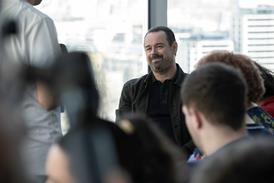CGI visual effects (VFX) is one of the fastest changing technologies within broadcasting and the film industries. And the complexity of CGI VFX in broadcasting no longer lags behind the movie world. Nowadays you're just as likely to see cutting edge CGI VFX on TV as in a multimillion dollar blockbuster. However, on TV it is science documentaries, rather than science fiction films, where state-of-the-art VFX are particularly in demand.
“Documentary producers like to stimulate their audiences with effects or techniques that have been seen on the big screen,” says Andy Davies-Coward, creative director of 422 South. “The budgets are vastly reduced, but the aims are often just as high. Luckily, there's a trickle-down effect in terms of software and know-how that makes them more affordable.”
Pioneer Productions is well known for science-based documentaries such as In The Womb (C4, NatGeo) and Naked Science (NatGeo US). Managing director Stuart Carter believes there has been a growth in science-based programmes because of a heightened awareness by broadcasters of what VFX can deliver.
“People do want high-end visuals, either to do impossible things (such as looking inside the human heart), or seeing into impossible worlds (such as far-flung galaxies),” he says. “It's spawned many new commissions.”
Louise Hussey, feels that visual effects are on the increase in UK TV productions as producers become more accepting of their value.
Rushes was recently nominated for an Emmy for photorealistic VFX in the Dangerous Films/Discovery documentary series Human Body: Pushing the Limits, but Hussey doesn't feel the critical acclaim has made life easier.
“VFX houses are certainly not thriving on the back of any extra work they might be undertaking,” she says. “The rates are still pressured for broadcast work.”
Phil Dobree, company director of Jellyfish, also feels VFX houses are being pushed to the limit. “With television budgets continually decreasing, the greatest challenge is to find ways of creating absolutely convincing shots with limited time and money.”
Jellyfish won Bafta and RTS awards for its highly realistic work on the BBC/Discovery series Fight for Life, pushing the CGI envelope with innovative ways to animate and simulate fluids and organ texture at a microscopic level.
Dobree feels producers should learn from the workflow used on VFX-heavy films, where VFX houses are increasingly getting involved from the outset. “If TV production companies start working earlier with VFX companies and secure the necessary research and development budgets, then innovative, high-rating VFX programmes will become more achievable and desirable.
“Budgets are always the greatest problem facing the television industry but innovation and excellence is what brings in audiences. Audiences are also much wiser to good and bad VFX, and trying to achieve film-type shots on shoestring budgets is a tall order.”
Mike Davis, VFX producer at Darlow Smithson, adds that stylised landscapes and environments created by shooting against green screen - as seen in the likes of Sin City and 300 - can be achieved on TV budgets, but with limitations.
“Every commissioner is looking for an ‘application' for the kind of innovative digital effects seen in recent blockbuster movies. However, full CGI characters and environments as demonstrated in Beowulf have a movie-size million-dollar-per-minute price tag that some execs or broadcasters find hard to justify.”
That's not to say British facilities are not up to the challenge. For recent Wall to Wall documentary Sex and the Neanderthals: Revealed... (Five), animators Bryan Servante and Aline Sudbrack at Prime Focus London created a time-lapse effect for an organic 3D ancestral family tree. “Maya Paint Effects was used to grow branches in a controlled manner, flourishing and diverging as the human population evolved over time,” explains Servante.
Another shot travels down a hair strand to the chromosome level. “We predominantly used Maya and built bespoke custom shaders to give a feel that was classic electron microscope, but which also had a beautiful colour and lighting pass for a more visually stimulating and unique look,” says Servante.
As remarkable as this animation is, CGI cannot replicate everything. Some of the effects in the Wall to Wall documentary also used optical effects, courtesy of Clark Associates, and many documentaries still make use of physical models for realism.
“Some of the old tried-and-tested techniques of shooting models and filming in slow motion are still hard to match in CGI,” says Stuart Carter, who adds that Pioneer regularly uses a pool of around six British companies for its visual effects, including Red Vision. “Virtually everything we do now is for HD so the quality has to be fantastic. There are certain textures, particularly human skin, which nobody has got quite right in CGI.
“If you build a model it looks a little better, which may be to do with scale or how our eyes work. Medical CGI imagery is still a bit ‘computerish' but the textures are getting better. Of course, we don't know what the surface of a human heart really should look like, but human skin is the one thing we are all familiar with.”
Carter adds that the current challenge for Pioneer is creating VFX for a slate of geology shows that recreate how early Earth would have looked.
“How do you show an eruption that occurred several billion years ago and that covered the American continent with lava to a depth of one mile. You've got to make it look photorealistic. We can film some real landscapes and put the action on top of that, but we have to get lava to fountain in a way that looks realistic. Like water, it's a flowing thing.”
Much of the CGI work in the science documentary genre involves cutting-edge techniques and makes innovative use of data from other fields. One example is the work of 422 South, which created ground-breaking CGI sequences for the BBC's multiplatform production Britain From Above. For the central three-part BBC 1 series, fronted by Andrew Marr, series director Cassian Harrison wanted to use GPS data derived from a variety of sources to show different forms of human activity.
“The sources of data included the National Air Traffic Service, the Coastguard, a London taxi company, HGV operators, BT and others,” explains creative director Andy Davies-Coward. “Each supplied raw GPS data based on geographic co-ordinates set against a timeline. The amounts of data were vast. 422 first had to write code to examine the data, then cleanse it of extraneous information, then extract the most revealing segments and translate it into a form that could be imported into and used within Maya animation software.”
Once in Maya, dedicated “brushes” were created to give topics their own character. “So taxi movements were shown as orange streaks, HGV traffic in flickering green traces, while BT telephone exchange activity was shown as spidery golden pulses,” says Davies-Coward.
It was then left to art director Dave Corfield to overlay the Maya outputs with satellite imagery of the UK landscape using Shake compositing tools.
The track record of UK facilities in carrying out complex VFX work for factual doumentaries has attracted commissions from the US and Canada. Pioneer Productions has just been commissioned by National Geographic Channel and Discovery Channel Canada to make the ambitious Journey to the Edge of the Universe.
Using a single, unbroken shot, this epic voyage across the cosmos relies entirely on CGI. Based on scientific research and photographs taken from the Hubble space telescope, visual sequences explore the science and history behind our solar system and neighbouring galaxies.
According to Carter, it would not have been possible to make this kind of programme for TV even a couple of years ago, because it was too expensive or because the computer software was not good enough. But technology is moving on all the time, creating a big impact on what VFX specialists do and the commissions they receive.
“I've been very interested to see how motion capture, whether capturing an acted or puppeteered performance, is influencing character animation practices and pipelines,” says Davis.
“Having used this technology on a recent pilot myself and observed how efficiently it was employed on Red Vision's recent ITV comedy Headcases, I can foresee plenty of opportunities for more virtual characters/presenters across TV genres.”
Thomas True, an applied engineer for graphics card manufacturer NVIDIA (used in many VFX computers) feels that new CGI effects in broadcasting are being driven by a combination of film R&D and the power of the graphic processor unit (GPU), the chip that creates the graphics.
“Film post-production applications that exploit the parallel processing capabilities of the GPU are moving into the much more cost and time sensitive broadcast TV post-production pipeline,” he says.
Jonathan Privett, director of 3D at Rushes, thinks it is likely that the VFX on TV will get more sophisticated. “In the end it is the desire to create appropriate content to enhance the programme that will lead progress,” he says.
Davies-Coward feels that ideas are the main driver. “There's a Zeitgeist element - certain techniques come to the fore because they answer some kind of emerging need,” he says. “Britain From Above was a great example, stimulated by a developing awareness of what is possible through resources like Google Earth and all those coffee table books of aerial photography.”
Lion TV's Mike Davis believes that innovations in CGI should be driven by great ideas rather than the other way around. “I think we will start to see an increase in animation being used in factual TV,” he adds.
“Look at the success of ‘animated documentary' Waltz with Bashir at Cannes this year and other theatrical documentary releases with large sections of animated content like Chicago 10. This will filter down into TV and allow true, powerful stories to be told with more emotion, surrealism and expressionism.”
Outstanding VFX: the pros and cons
It's obvious that there is more CGI on TV than ever before, but the drive for the greatest and best VFX could have an adverse impact on the UK CGI market. Rushes VFX producer Louise Hussey feels that state-of-the-art VFX in the latest Hollywood blockbusters challenges the TV VFX industry to provide similarly complex work at a very small percentage of the cost. “This can lead to work being outsourced abroad, where advantageous tax breaks can be utilised to keep costs low,” she says.
Darlow Smithson Productions is exploring overseas VFX options, but VFX producer Mike Davis says such relationships often come about because of the necessity of international co-productions more than through choice.
“As sophisticated and fast as file transfer and video conferencing is becoming, nothing gets better results than being able to talk directly to the leads on the project. This risk is reduced if there is a good creative and managerial point of contact in the UK who can interact directly with the client.”
422 South seems to offer such a route. “Do we use overseas subcontractors?
Yes, we have a trusted relationship with a brilliant team in Brazil,” says creative director Andy Davies-Coward.
“The reason is obvious: the pound is strong against the US dollar, which provides much of the funding of TV in the UK. Working with Brazil neutralises the discrepancy between the two currencies.”
“When we make use of this option we're usually open about it with clients,” he continues. “They know we take responsibility for the final quality by directing and managing the process from our offices in Bristol, while still being able to pass on the benefit of lower overall costs,” he adds.
However, Jellyfish company director Phil Dobree fears that pressure on UK VFX facilities may prompt a “race to the bottom” in which budgets are everything and quality is sacrificed.
“Mistaking VFX as a technology-driven industry rather than a people-driven industry is a premise born out of ignorance of the process. It's probably incumbent upon the VFX industry to open up our ‘black boxes' and demystify the process so clients understand the costs, techniques and skills involved.”




























No comments yet